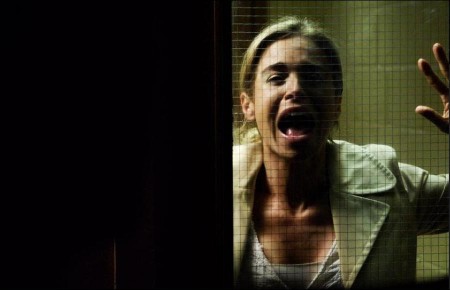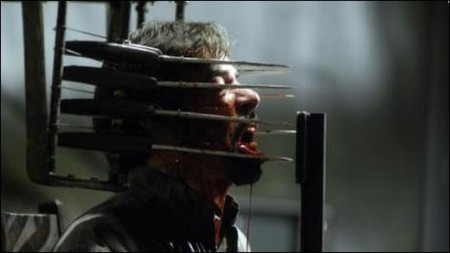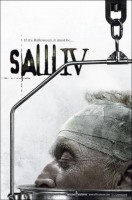Tagline: For every death, there is a new life…. Jigsaw’s baby takes over.
“What the fuck is going on? Where am I?”
Those words, uttered two minutes into 2004’s SAW, express the primal emotions – the hopeless confusion, the awful sense of powerlessness and sheer, panic-stricken terror – that lie at the heart of Lionsgate and Twisted Pictures’ SAW franchise; emotions that are a key to its phenomenal success.
The SAW films follow the machinations of Jigsaw, a terminally ill cancer patient with an exacting moral agenda and a genius for gruesome games of survival, “played” with those he believes have ceased to value and appreciate the gift of life. Ratcheting up tension with each successive film, the SAW franchise has touched a chord while jangling millions of nerves worldwide.
It has picked up the baton from classic horror series such as Halloween and Nightmare on Elm Street to become a cultural touchstone, as well as the most profitable horror franchise, both theatrically and on DVD, in movie history. To date, the three SAW titles have taken in over $400 million in worldwide theatrical box office and their combined net DVD sales exceed 13 million units. The franchise has helped make Lionsgate the leading studio for horror today, with #1 rankings in box office and DVD consumer spending.
SAW made its world premiere at the 2004 Sundance Film Festival as part of the Festival’s popular “Park City at Midnight” program. Festival Director Geoffrey Gilmore, who programs the annual event, recalls that he was impressed by the first-time filmmakers’ command of both form and theme. “SAW grabbed the viewer from the first frame; it was bold, cleverly constructed and flat-out terrifying,” he comments. “But what really set SAW apart was its moral seriousness. This movie didn’t just want to scare you, it wanted to make you think about what you would do to stay alive. In today’s world, that is not a trivial thing to contemplate — either as an individual or as a member of society.”
As the SAW series has continued, the films have tunneled further into Jigsaw’s beliefs and worldview. Says Leigh Whannell, who created the original story with director James Wan and wrote or co-wrote the screenplays for SAW, SAW II and SAW III, “Jigsaw’s cancer has led him to think very hard about what it means to be alive and how close we are to death at any given time. But he’s not someone who stops with a simple `carpe diem’ and a trip to Europe. The concept of life’s value becomes a springboard to look at other personal moral choices, like forgiveness versus retribution. Jigsaw keeps digging into these issues, which become grist for his games. And as twisted as the games are, his intention is to help people. Between his philosophical bent and his sick take on altruism, I like to think Jigsaw is somewhat unique in the horror universe.”
The SAW franchise has been part of a wave of horror films that have drawn favorable comparisons to the independent horror cinema of the 1970s, a connection highlighted in a Summer 2007 series at New York’s Museum of the Moving Image, entitled “It’s Only a Movie: Horror Films from the 1970s and Today.”
The six-weekend retrospective drew a thru-line between films like Wes Craven’s LAST HOUSE ON THE LEFT (1972) and Tobe Hooper’s TEXAS CHAINSAW MASSACRE (1974), which shocked audiences of their day with envelope-pushing gore and disturbing explorations of human behavior; and the films of the SAW age, including Darren Lynn Bousman’s SAW II, which contain images and stories that have left today’s viewers just as stunned and terrified — and eager for more — as the moviegoers of the 1970s. “It’s Only a Movie” presented double features that paired films from each era, with SAW II sharing a bill with Stanley Kubrick’s A CLOCKWORK ORANGE.
Announcing the series in June 2007, the Museum’s Chief Curator, David Schwartz said, “These movies are of considerable aesthetic and cultural interest, clearly reflecting the fears of contemporary lives…. Of course we are aware that these films contain disturbing, often shocking images, but they are powerful precisely because they tap into our deepest anxieties.”
Assistant Curator Livia Bloom also weighed in. “The filmmakers in this series use the horror genre as a commercial framework to make smart, often subversive films. Their work examines deep psychological concerns, and comments on social and political issues of the day.” Bloom noted that in SAW’s “startling scenes of torture,” she found “reflections of a life during a time of war and turmoil.”
The thematic and stylistic consistency of the SAW series owes much to the stewardship and participation of a core team, including SAW originators James Wan and Leigh Whannell; writer/director Darren Lynn Bousman, who joined the team with SAW II; producers Oren Koules, Mark Burg and the late Gregg Hoffman; and executive producers Stacey Testro, Peter Block and Jason Constantine. The key creative team has been with the series from the start, and includes director of photography David Armstrong; production designer David Hackl; editor Kevin Greutert; and composer Charlie Clouser, a onetime member of the band Nine Inch Nails.
Another critical member of the SAW team is actor Tobin Bell, who has portrayed Jigsaw throughout the franchise. In his September 7, 2007 essay on contemporary horror movies in the L.A. Weekly, critic Luke Thomson wrote, “Tobin Bell’s performance as Jigsaw is a wonder; he’s the best `real-world’ horror antihero since Anthony Hopkins first played Hannibal Lecter.”
As intricate as one of Jigsaw’s games, the SAW films reveal their twisting plots gradually. The series itself resembles an even larger jigsaw puzzle, with each new film linking up in some way with its predecessor. With SAW IV arriving in theatres for Halloween 2007, let’s take a look at the pieces thus far. To paraphrase Jigsaw’s victims: where are we?
Giving Til It Hurts: The Annual Saw Blood Drive
The SAW franchise is not only about big-screen blood; it also about the blood that saves lives. With the release of the first SAW in 2004, Lionsgate and Twisted Pictures embarked on a cutting-edge promotion tailored specifically to the franchise’s profile: a nationwide SAW blood drive that exhorts fans to “Give Til It Hurts” to benefit the Red Cross. The SAW “Give Til It Hurts” Blood Drive has become a key element of the SAW franchise, as much a part of its annual rituals as the Halloween premiere date. Each year brings a new ad campaign photographed by Tim Palen, Lionsgate Co-President of Theatrical Marketing and fine art photographer, and featuring the SAW nurses, seductive angels of questionable mercy and considerable visual impact. In the first three years of the blood drive, SAW filmgoers donated nearly 38,000 pints of blood to help save as many as 112,500 lives.
This year, the SAW “Give Til It Hurts” Blood Drive has acquired two important new partners, the American Red Cross and Yahoo!, to help make this year’s campaign is bigger, better and more bloodily ambitious than ever. Lionsgate and the American Red Cross entered into their first formal partnership to administer the SAW IV Blood Drive on a nationwide basis. The national organization will join local Red Cross chapters in setting up donation centers, a commitment that will more than quadruple the number of centers, from 250 to 1200. SAW star Tobin Bell is featured in several PSA’s advertising the event.
Meanwhile, Yahoo! is providing massive online support for the SAW IV Blood Drive as Lionsgate and Twisted Pictures’ key online partner. In addition to providing hundreds of millions of impressions across Yahoo! News, Yahoo! Mail, and Yahoo Movies, Yahoo! is also hosting the Blood Drive website. By searching for “Saw Blood Drive” on Yahoo!, users can access the SAW IV Blood Drive website, which features a branded, interactive Yahoo! Map that allows users to find the closest Blood Drive to their geographic location. In addition to the interactive map, users can watch the Blood Drive PSA with Tobin Bell, grab branded downloads, and tell a friend about the Blood Drive.
The SAW IV Blood Drives are taking place at college campuses and other locations across the country. Field drives began the week of September 16, 2007 and Red Cross blood drives began the week of September 23rd. The SAW IV Blood Drive will continue through the first week of SAW IV’s release.
Lionsgate’s goal for the SAW IV drive is to gather 60,000 pints, more than 2½ times the amount collected in 2006. Collection totals from the SAW blood drives have doubled year after year: during the 2004 inaugural drive, 4,200 pints were collected, in 2005, 10,000 pints were collected, and in 2006, 23,493 pints were collected, resulting in tens of thousands of lifesaving blood transfusions.
Production notes provided by Lionsgate Films.
Saw IV
Starring: Tobin Bell, Scott Patterson, Betsy Russell, Costas Mandylor, Lyriq Bent, Athena Karkanis, Justin Louis, Simon Reynolds
Directed: Darren Lynn Bousman
Release Date: October 26, 2007
MPAA Rating: R for sequences of grisly bloody violence and torture throughout, and for language.
Studio: Lionsgate Films
Box Office Totals
Domestic: $63,300,095 (45.4%)
Foreign: $76,052,538 (54.6%)
Total: $139,352,633 (Worldwide)



